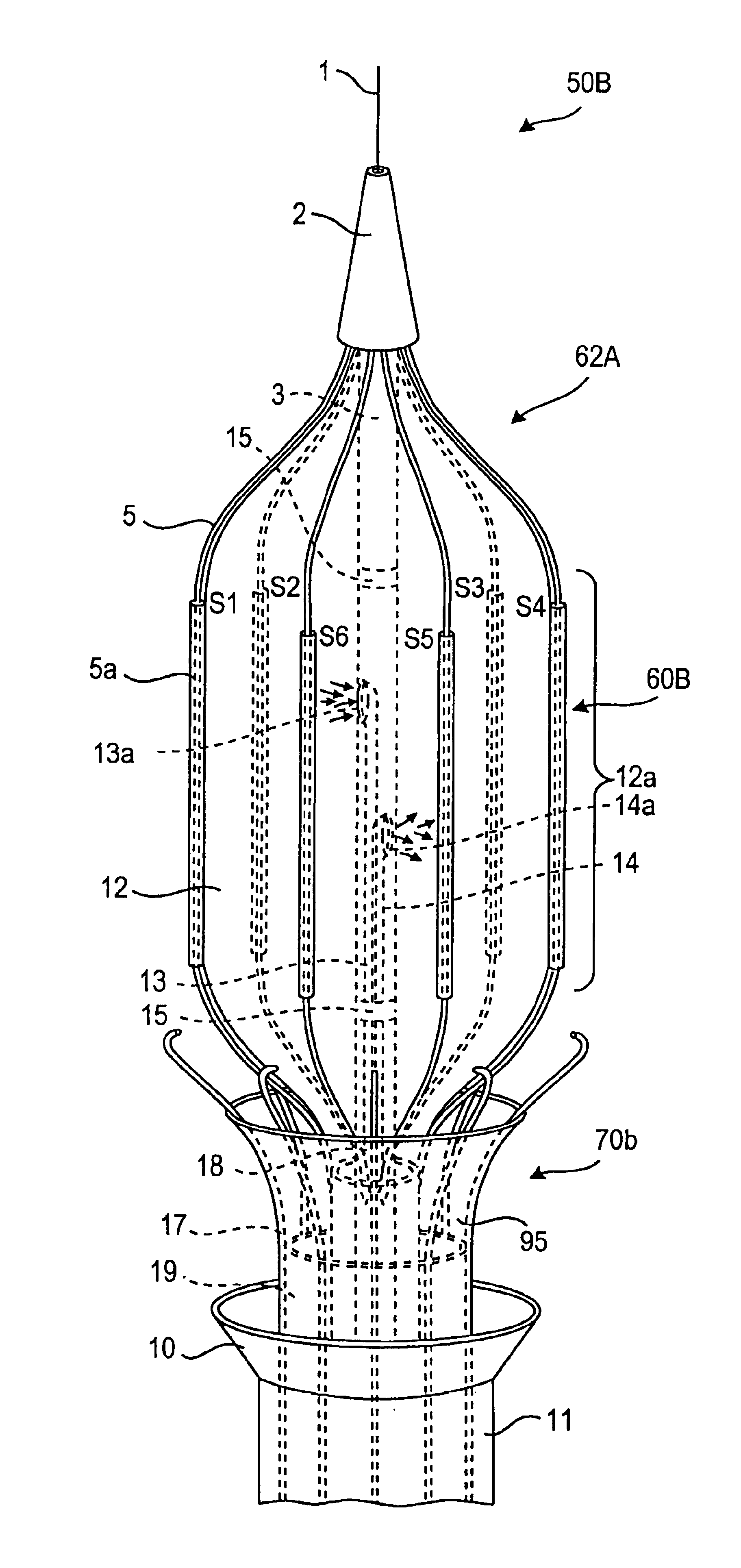Methods for delivering, repositioning and/or retrieving self-expanding stents
a self-expanding, stent technology, applied in the field of advanced medical endoluminal devices, can solve the problems of stent entrapment, stent entrapment completely in the vessel wall, bes are less flexible than self-expanding stents, and are less capable of being delivered through tortuous vessels, so as to enable the precise positioning of the stent
- Summary
- Abstract
- Description
- Claims
- Application Information
AI Technical Summary
Benefits of technology
Problems solved by technology
Method used
Image
Examples
first embodiment
Referring now to the drawings in which like reference characters designate identical or corresponding parts throughout the several views, and more particularly to FIGS. 1-3, apparatus in accordance with the invention comprises a catheter assembly 50A (only the distal end region of which is shown), a thermal transfer device 60A connected to catheter assembly 50A and an associated stent capturing device 70A. Catheter assembly 50A comprises a low profile outer core catheter 8, having an inner movable core catheter 3, an inner stent-capturing sheath 19 situated over the outer core catheter 8, and an outer stent-receiving sheath 11. In this embodiment, the thermal transfer device 60A comprises a frame assembly 62 to which an expandable balloon 4 is connected. Balloon 4 has a sleeve-type configuration, i.e., the balloon 4 has an annular cross-section along its entire length. As discussed below, this shape is advantageous since the flow of blood or other body fluid which normally occurs in...
second embodiment
the invention shown in FIGS. 4-7 also incorporates apparatus for circulating a thermal transfer fluid into and from the interior chamber of balloon 12. While the inner moveable core 3 has a central lumen for the guidewire 1 in the same manner as in the first embodiment, two continuous channels 13 and 14 are provided in the inner core 3. Channels 13 and 14 extend from the proximal end of the inner core catheter 3 and open at respective ports 13a and 14a situated within the chamber of balloon 12. Channel 14 is used for infusion of a thermal fluid into the chamber of balloon 12 while channel 13 is used as an outflow channel. By suitably connecting the proximal end of channel 14 to a pump, or other source of infusion of thermal fluid, and by suitably connecting the proximal end of channel 13 to a collecting container, a constant circulation of the thermal transfer fluid through the balloon 12 is achieved. Alternatively, the thermal fluid can recirculate through a closed circuit pump sys...
third embodiment
Referring to FIGS. 13-16, a first version of apparatus in accordance with the invention comprises a thermal transfer device 60C associated with a catheter assembly 50C and including a stent capturing device 70C. The thermal transfer device 60C comprises an inflatable and collapsible balloon 20 formed of the same type of material as that from which balloons 4 and 12 are made. The balloon 20 has a cloverleaf configuration in the cross sectional view (FIG. 14a). Balloon sectors 201-204 merge with each other at the proximal and distal ends of the balloon (FIG. 14 and FIG. 15) and in the center of the balloon define radial spaces 201-4, 201-2, 202-3 and 203-4 between them (FIG. 14a). Each of the radial spaces are formed by a pair of opposed radially and axially extending wall members 94 extending between the outer wall of balloon 20 and the inner core catheter 3. The distal end of the balloon is attached to the inner core catheter 3 at the attachment of the cone 2 and the proximal end of...
PUM
 Login to View More
Login to View More Abstract
Description
Claims
Application Information
 Login to View More
Login to View More - R&D
- Intellectual Property
- Life Sciences
- Materials
- Tech Scout
- Unparalleled Data Quality
- Higher Quality Content
- 60% Fewer Hallucinations
Browse by: Latest US Patents, China's latest patents, Technical Efficacy Thesaurus, Application Domain, Technology Topic, Popular Technical Reports.
© 2025 PatSnap. All rights reserved.Legal|Privacy policy|Modern Slavery Act Transparency Statement|Sitemap|About US| Contact US: help@patsnap.com



